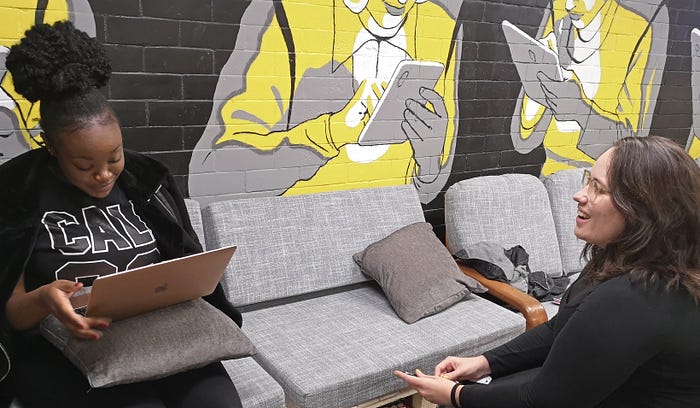Sharing All The Value: A practical contribution to building equity in research & design practice
We’re a small new team, based out of Collaborative Future, working with a network of partners to make a practical contribution to fundamentally more equitable practice in research and design.

Despite a move towards more participatory practices in research and design across civil society, academia and government, most of this work is still shaped by fundamental imbalances and inequities. These are normally present within every stage and layer of these processes, from who shapes and leads them, to where the money invested in them is allocated, to who makes the decisions that emerge from them.
This team, made up of Tess Cooper, Alvin Owusu, Sonia Tyrna, Nick Stanhope and Prisca Munzemba, is taking on one part of this: the fair distribution of the value created by research and design processes.
Through the prototyping and testing of a new platform, we’re looking to answer questions like:
- How can fair payment to contributors to research and design become the norm across civil society, academia and government? How can we make these payments easy to offer and take-up?
- How can the people and groups that are the focus of research and design get much more agency in deciding the roles and forms of value they want from these processes?
- How can lots more of the value from these processes, such as data and IP, be shared meaningfully with the people and groups that contribute?
Our intentions
With these questions in mind, we’re setting out with two intentions:
- Redistribute the value created
Big money flows through government, grant funders and other commissioners into agencies, universities and other bodies for research and design. And these processes generate data, IP and other assets, as well as other forms of substantial value, such as credentials, social capital and opportunities for more funding and commissioning. The people and groups intended to benefit from the outputs of work normally get a scrap of this value. We want more of this money and these assets to flow directly into the hands of these people and groups, by shifting norms, unlocking barriers and facilitating the transfer. - Shift the agency and control
From decisions about participation in research and design processes, through to framing the fundamentals of what forms of research and design are needed and important, agency and control rests mainly outside of the people and groups that are the subjects of this work. We intend to play one role in a network of interdependent actors that are working to shift this power in different ways, whether it’s investing in Community Researchers through Centric or increasing representation and equity in research and design teams with the School.
Our experiences, what we understand and what we’re learning
The team and network working on this represent lots of different experiences of both inequitable and more mutual research and design processes. We will all share these and what is most important to us about this work.
Personally, as a social sector designer of 15 years, I’ve led or been part of far too many projects that privilege the research or design team and the client, commissioner or funder over the people and groups that are intended as the focus (or stated as such). And efforts at change, in the name of participatory research or co-design, have (and I’m talking from my own efforts and experience, no-one else’s) been well intentioned but ultimately superficial and likely harmful. I’m embarrassed to admit that. But it does mean that I understand, within civil society, academia and local government, some of the real and perceived barriers to change. These include:
- Default to the path of least resistance — due to real and perceived issues in areas like procurement, tax and benefits, as well as the refusal to listen and prioritise the people and groups affected by research and design, there is a default to the processes that require least bandwidth on behalf of the organisations and institutions running them
- Underestimation of value — those planning and running research and design projects have tended to underestimate the real value of the roles and contributions (i.e. the stories, data and insights at the heart of research and design) of the people and groups they engage to participate and overestimate the value of their own roles. With little accountability for these estimations of value, they are reflected in budgets, roles, decision-making and everything else.
- Underestimation of harm — there is a parallel underestimation of the potential harm of inequitable research and design practice. These risks of harm exist at every point, from the way in which a short interview with a researcher about mental health services might trigger painful experiences of being dehumanised and patronised when trying to access care, through to the unfulfilled expectations raised by these processes and what might come from them.
- Low awareness and imagination — stuck in conventional ways of doing things, like creating modest, one-off forms of participation or handing out Amazon vouchers, and lacking an appetite to explore new approaches, higher standards and different forms of relationships
- Low standards and expectations — there is a growing movement of funders that expect more, seen through Wellcome Trust’s Public Engagement commitments; Impact on Urban Health’s investment in community research practice and models; the multifaceted work of Lankelly Chase to support locally led collaborative change processes; and UKRI’s vision for public engagement. But, ultimately, it’s still normal and acceptable to submit a research and design budget with little or no contribution to the people and groups that are stated as the focus.
As we talk to more of the people and groups that have (or haven’t) been involved in research and design, more of the teams that currently run them and more of the funders and commissioners that invest in them, we’re learning more about these kinds of issues. And, by working with partners like Centric and finding examples of how things can be done, we’re glimpsing what better, more equitable research and design, where all the value is shared fairly, can look like.
What next and getting involved
We’re doing 4 things at the moment:
- Building our network of those that are taking on or affected by some of these questions
- Working closely with individuals, teams and organisations to learn about their experiences, the barriers they face and the opportunities for change
- Building and testing prototypes, from an open FAQ to lightweight processes for managing multiple payments
- Looking for grant funding to cover the time of the team and those contributing
Whether you’re a previous, current or potential participant in research and design; part of a team or project leading these processes; a community researcher trying to push even more value into the people and groups you work with; or a funder or commissioner trying to raise the standards of equitable research and design you invest in — or anyone else interested in this — we’d love to hear from you. E-mail hello@collaborativefuture.co.uk
